Blurring the Lines, Part I: A Promising New Trainer Aircraft and Its Combat Variants
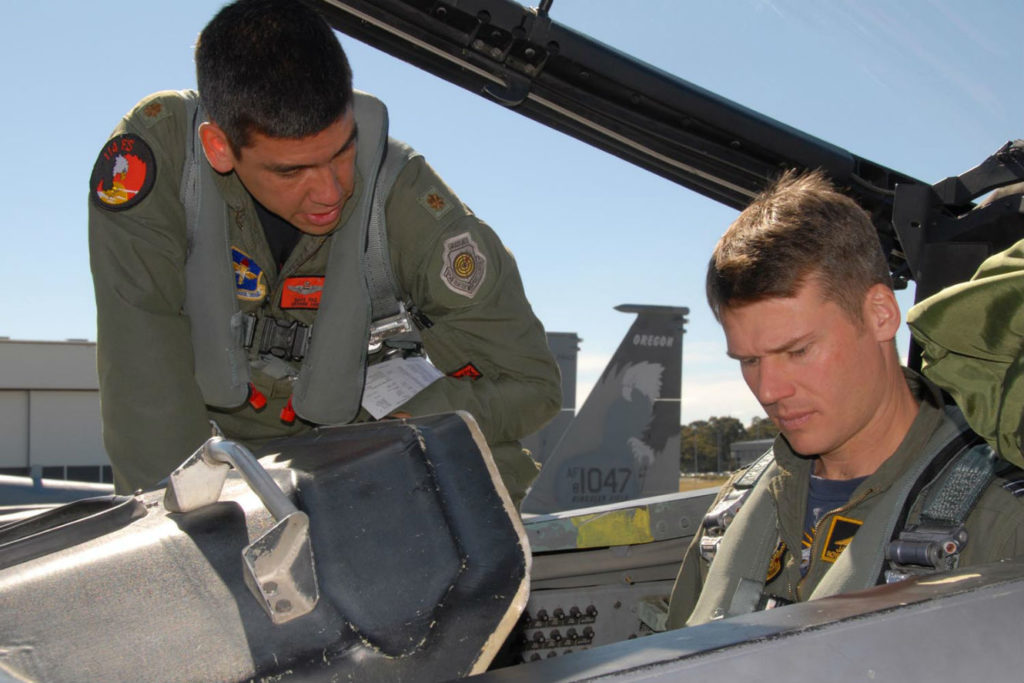
Editor’s Note: This is the first installment of a three-part series on new approaches to airpower called “Blurring the Lines.”
In the 1950s, Northrop Grumman designed a lightweight fighter wrapped around two compact jet engines, designed for the Navy’s escort carriers. Soon after, the Navy dispensed with escort carriers entirely, so the N-156 was instead offered as a supersonic trainer to replace the Air Force’s aging T-33s, the aircraft then used to train pilots to fly jets. The N-156 entered service in 1961. Eventually, Northrop would build 1,146 of the aircraft, renamed the T-38 Talon. The Talon served as the airframe for the highly successful F-5 Freedom Fighter, which has been in frontline service since 1962. The F-5A Freedom Fighter entered service in 1962, with a second version (the F-5E), following in 1973. Widely employed, including in combat operations with the Air Force in Vietnam, the F-5 is still in service — as is the T-38.
With the selection of the Boeing T-X to be the Air Force’s next-generation trainer aircraft, the service again has the opportunity to make a combat aircraft out of an existing jet trainer — only this time, planned in advance. The coming introduction of the T-X could allow the Air Force to get more bang for its buck, rolling together trainers, jet attack aircraft, and lightweight fighters that are all drawn from a common design. This would, in effect, blur the lines between trainer and combat aircraft in a manner that has been highly successful before. Using a common airframe for multiple roles could very well be cheaper, faster to develop, and easier to support from a common logistical pool. Given that new aircraft programs often take decades to mature at exceptional cost, developing a single airframe in many different ways can offer a way to break out of a long, slow, and difficult acquisition process. Why not take an aircraft designed to have “fighter-like” characteristics and make it into a fighter? The Air Force should pursue rapid prototyping effort to create a new lightweight fighter series, leaping at the opportunity to repeat a successful aircraft program from the past.
This article is the first in a three-part series intended to offer policy options for airpower that break out of the existing paradigm for training forces or employing forces, or which otherwise depart from the comfortable complacency that all large organizations find themselves in from time to time. In many cases, some of which we will call out, the Air Force has entered an “accepted” way of doing things without adequately considering how we got there and why we should stay. Alongside these ideas, we will offer historical examples of how and why the Air Force did things differently, and why it should reconsider “old” ways of doing business. In all of our cases, we are advocating a reexamination of the strict boundaries the institution has placed upon itself in pursuit of the mission and how those lines may be “blurred” to examine other options.
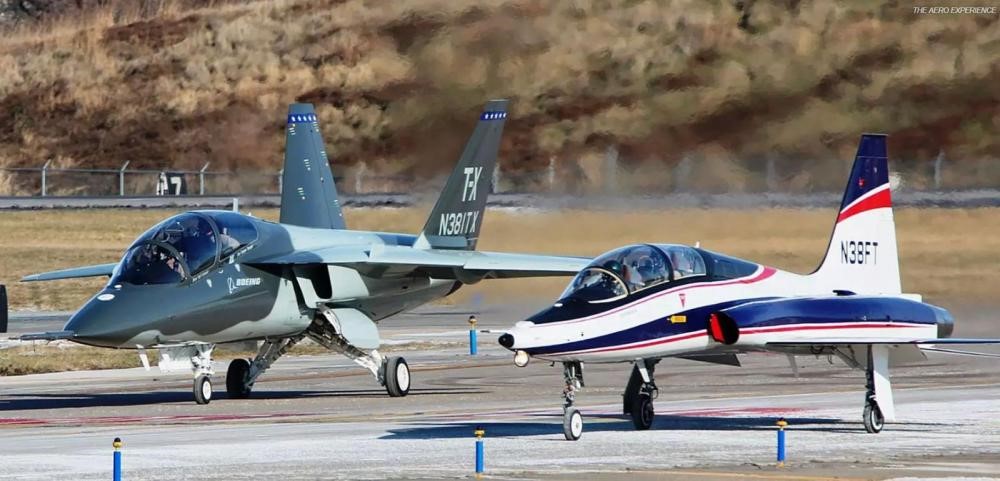
Figure 1: T-X (left) and T-38 (right). (Photo by Mark Nankivil, The Aero Experience)
The T-X and Combat Variants
The T-X competition was an Air Force contest to determine what the T-38 replacement was going to be (T = trainer, X = unknown). The Boeing/Saab entry, cheekily named “T-X” from the start, won the competition. The aircraft’s sleek lines have “fighter” written all over them, which is eminently sensible for an aircraft intended to train students who will someday fly fighters. Boeing won the competition partly because of a low cost to build, meaning a combat aircraft program wouldn’t be burdened by an expensive basic airframe. In many respects, the design philosophy mirrors the aircraft it is slated to replace — a half-century later. The idea is the same: Train pilots who may fly fighters in an aircraft that performs like a fighter.
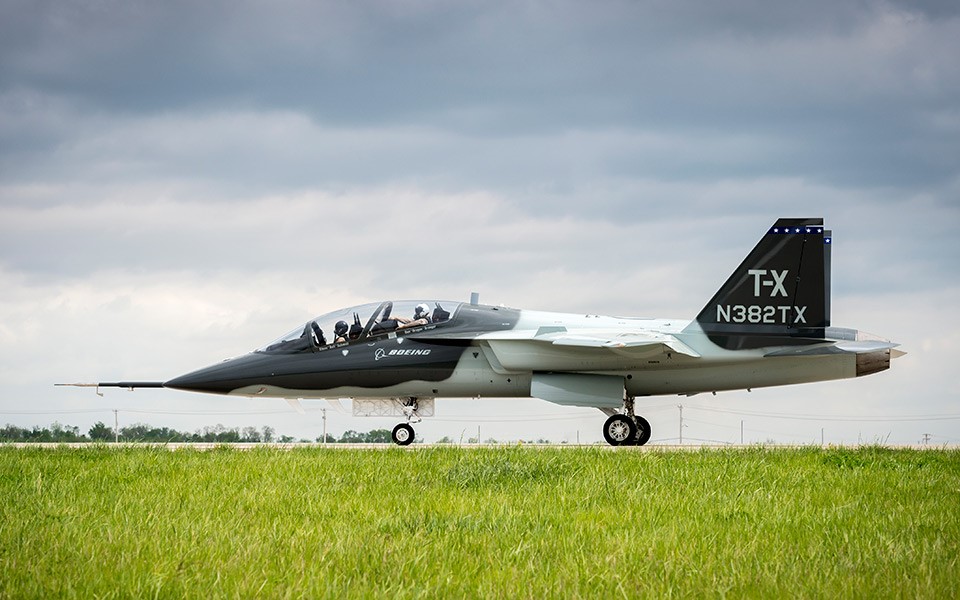
Figure 2: T-X during taxi test (Boeing)
We have previously floated the idea of combat variants of the T-X, called AT-X and FT-X. In our vision, we want to keep the combat variants light and limit the cost by avoiding making a single variant of a trainer aircraft also do all things fighter/attack. The FT-X would look remarkably like the stock T-X on the outside and be focused on counter-air missions against enemy missiles and aircraft with an advanced radar supporting a missile-and-gun armament. The AT-X, for its part, might look like a beefier version of its parent, capable of carrying heavier air-to-ground munitions and penetrating hostile airspace, but still with respectable air-to-air capabilities for self-defense.
These two aircraft might well be the spiritual successors not only to the T-38 and F-5, but also to the Eagle and Strike Eagle — though the newer craft will be in a much lighter weight class than those heavyweights. Indeed, in many respects we expect a modern fighter to be built with the mission systems comparable to the so-called “Fifth Generation” aircraft, with T-X variants differing in shape from their stealthy siblings but not lacking advanced systems. Similarly, the variants could use similar weapons — the AIM-120 Advanced Medium Range air-to-air missile, the AIM-9 Sidewinder dogfight missile, and the all-weather, GPS-aided Joint Direct Attack Munition, a “smart bomb” that comes in 1000-lb (GBU-32) and 500-lb (GBU-38) variants.
Table 1: Notional T-X, FT-X and AT-X Numbers
Aircraft |
T-X |
FT-X |
AT-X |
Crew |
2 |
1 or 2 |
2 |
Empty Weight |
7165 lbs. |
7965 lbs. |
8390 lbs. |
Combat Loadout |
None |
4 x AIM-120 missiles2 x AIM-9 missilesGun Pack w/ 200 rounds |
2 x AIM-120 missiles2 x GBU-32, 4 x GBU-38 missilesGun Pack w/ 200 rounds |
Takeoff Weight |
12,125 lbs. |
16,625 lbs. (est) |
19,306 lbs. (est) |
Mission Avionics |
High-performance radarDefensive JammerInfrared Search & TrackRadar WarningTactical Datalink |
Multimode Radar/Terrain Following radarDefensive JammerOptical Targeting SystemRadar WarningTactical Datalink |
|
External Fuel |
No |
Maybe |
Yes |
These variants seem feasible. Table 1 shows differences between the three aircraft, each with a representative mission load. The FT-X is essentially a T-X with 500 pounds of equipment added (for radar, infrared search & track, datalink, etc.), a gun pack based on the Eurofighter’s lightweight 27mm gun, and six missiles. We envision that the radar on this aircraft would have the capability to pick small, stealthy targets like cruise missiles out of ground clutter — a necessary capability for an aircraft intended to serve a defensive counter-air role. If our bar-napkin calculations are correct, a fully loaded (hypothetical) FT-X could (theoretically) point straight up, engage afterburner — and accelerate.
The AT-X, the attack variant, would not be capable of that kind of performance because of heavier weapons loads and a higher mission weight. For our calculations, we kept the 500-lb avionics pack and also imposed a 13 percent weight surcharge on the AT-X for the ability to carry heavy weapons — the same weight differential between the F-15C and the F-15E. We assume its radar would still do air-to-air work but would trade very high-sensitivity target detection away for ground mapping, ground moving target indication, and terrain-following capabilities. Our notional weapons loadout is substantial — two 1,000-pound and four more 500-pound precision weapons (and their weapons racks), with a 27mm cannon and 200 rounds — plus two medium-range air-to-air missiles for self-defense. The AT-X variant would be designed to execute air-to-ground missions in a way that FT-X is not.
Missions
At this point, we’re discussing one very real trainer aircraft and a pair of notional fighter/attack aircraft in the same airframe — unsurprisingly very similar to how the N-156 turned out. What might the service use them for? We can expect that the operating costs of the T-X airframe will be lower than those of the legacy jets and much lower than those of their fifth-generation counterparts, which should make the T-X and variants cost-effective for both training and combat roles. The Air Force has long relied on a high-low mix of fighter capabilities to allow the force to remain broadly capable on a limited budget. A combat variant of the T-X would be a continuation of that philosophy.
FT-X could fill a role currently occupied by the aging F-15 Eagle. Air Guard F-15 and F-16 squadrons around the country maintain air sovereignty alert — the successors to the long-disbanded Air Defense Command. These units are ready, literally at a moment’s notice, to respond to airspace incursions, external threats, wayward aircraft and terrorist operations. The F-15 Eagle may be the best air-to-air jet ever built, and trading it in is not something we want to do; the FT-X would never be able to fill the larger fighter’s landing gear wells for the full range of F-15 missions. But keeping the F-15 is not an option, and replacing it with new builds is expensive. The FT-X could execute this essential mission at a much lower cost, avoiding the need to allocate expensive F-35s for a task they are less than optimal for.
The FT-X could also serve as aggressor aircraft, revitalizing a long-dormant capability that helped win Operation Desert Storm. The forward-based aggressor squadrons, long since cut out of the force due to budgetary pressures, were once a core part of the Air Force’s preparation for war, flying F-5E Tiger II aircraft to help counter the Soviet threat. Aside from its squadrons in Nevada and Alaska, the Air Force can no longer afford to dedicate aircrew or aircraft to this mission. Instead, fighter squadrons provide their own “Red Air” — fighter aircraft simulating hostile fighters (friendly fighters are always blue and the enemy red). The resulting asymmetry detracts from training, because those playing the “bad guy” burn flying hours pretending to be the enemy and miss out on training in their primary mission (although they do still get flight time in their fighter, which is worth something). Alternatively, the Air Force pays commercial companies to provide adversary air support, which also creates a brutal lack of symmetry because the money and flight time that the “adversaries” accumulate goes to civilian contractors, not Air Force aircrew. Bringing aggressors back “in-house” would ensure that every aircrew member in every flight is gaining valuable experience.
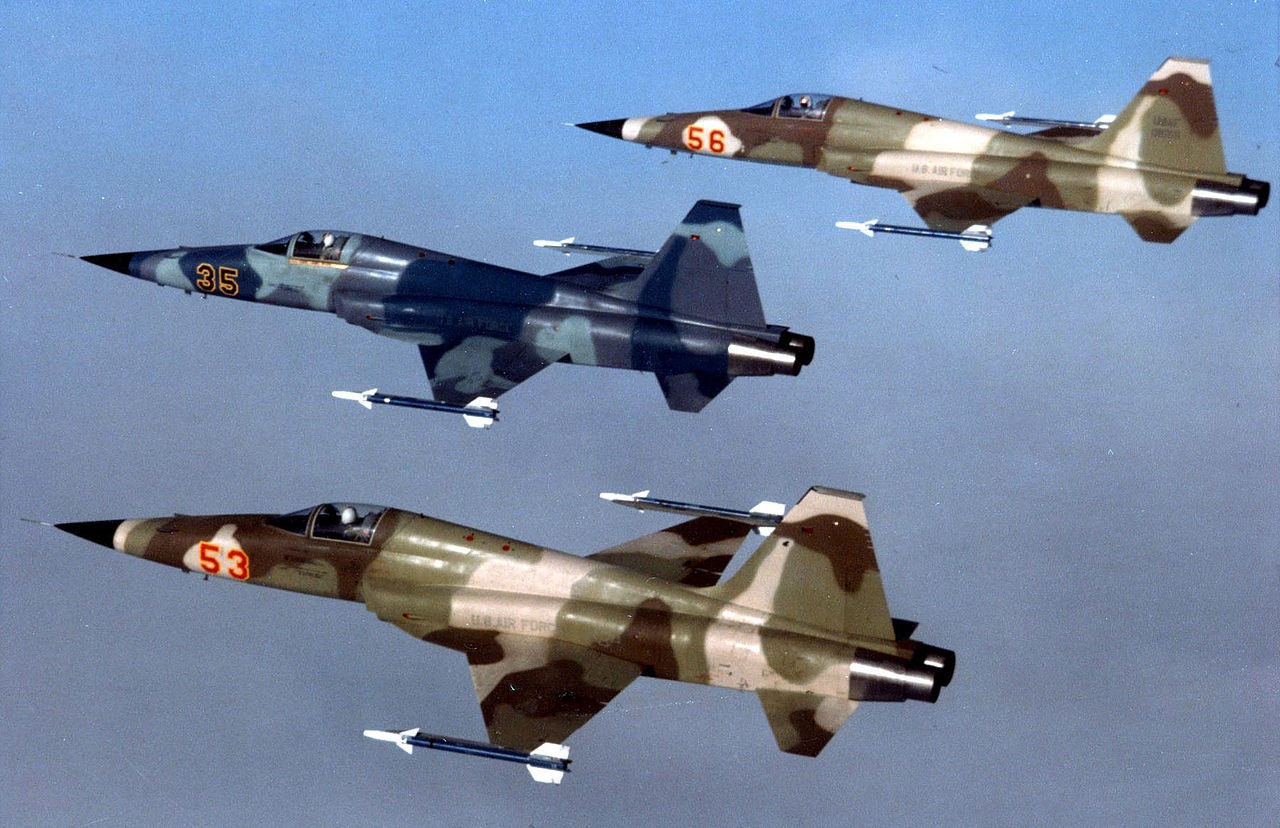
Figure 3: A formation of three U.S. Air Force aggressor Northrop F-5E Tiger II aircraft of the 527th Tactical Fighter Training Squadron, RAF Alconbury, United Kingdom, on 15 January 1983. (U.S. Air Force photo)
The AT-X is already being talked about inside the Pentagon as “third generation” light attack, that is, lightweight aircraft flying air-to-ground missions. OA-X is the second generation and the first generation all dates from Vietnam. Unlike OA-X, which is intended for austere fields and permissive airspace, AT-X would be intended for contested airspace, including the very low altitudes necessary for non-stealthy aircraft to avoid ground-based radar detection. The two-seat configuration provides a huge benefit here — previous fighter/attack aircraft capable of safe, low-altitude, terrain-following operations (e.g., the F-111, RF-4, and F-15E) have largely been two-seaters. With its high wing and raised air intakes, the AT-X may be able to operate from damaged or deteriorated airstrips, a capability that could be salient in a stand-up fight with a peer adversary. Even at our (notional) loaded weight, the AT-X is less than a quarter of the maximum takeoff weight of the F-15E with a similar thrust-to-weight ratio in afterburner, meaning it can use runways that won’t support the heavier jets.
While the AT-X could also fly aggressor missions for training purposes, its contribution might be far better if focused on providing the necessary live-fly training necessary to keep Joint Terminal Attack Controllers (JTACs) current and qualified. Like training with adversary air, the training benefits are symmetrical — aircrew gain valuable experience working with JTACS at the same time those JTACS practice their wartime mission with live aircraft. Training efforts may benefit greatly from some airframe commonality in ways not related to combat capability — the benefits of using the T-X to “apprentice” fighter aircrew were spelled out in War on the Rocks last week.
Indeed, in that article, no less a personage than Gen. Mike Holmes, commander of Air Combat Command, suggested pairing the T-X with fighter squadrons to improve the training enterprise. This pairing, he argued, would build more capable fighter aviators faster and cheaper than the current T-38 model. That model might also be suitable for use with the AT-X or FT-X, mixing combat variants of the T-X with legacy and fifth-generation fighters in the same wing. Thus, the “apprentices” in a fighter wing would gain time in a combat variant of the T-X trainer, providing additional combat capability.
No discussion of mission would be complete without considering the Air Force’s aerial demonstration squadron, the Thunderbirds. The Thunderbirds have flown both fighter and training aircraft, but mostly fighters. In 1974, the Thunderbirds switched from the mighty but fuel-sucking Phantom II to the fuel-efficient T-38 Talon — a supersonic trainer. Today, the Thunderbirds fly a combat aircraft again, the F-16. The F-16, in turn, could be replaced by a T-X variant, providing aerial demonstration capabilities at a lower cost. With the FT-X, the Air Force would not have to choose between an economical aircraft or a representative combat aircraft — it could have both.
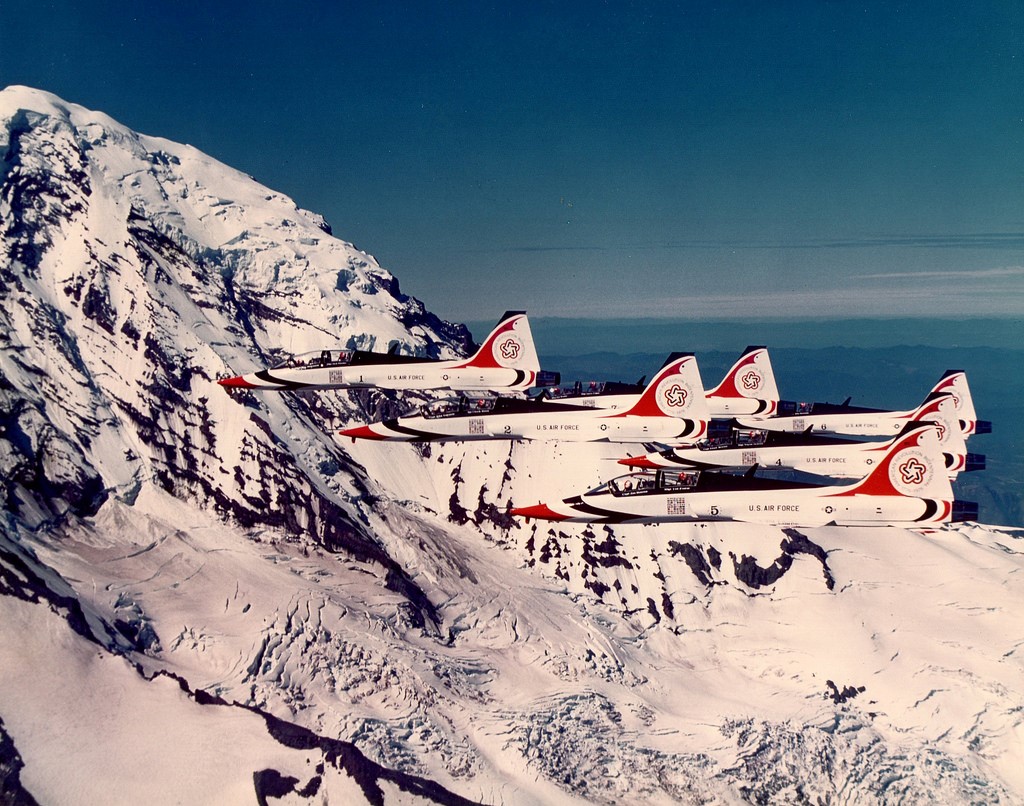
Figure 4: Air Force T-38 Thunderbirds show off their bicentennial paint scheme (U.S. Air Force photo)
The Technical Benefits of a Common System
The benefits of sharing a common baseline system go beyond just appearance. Systems commonality makes sense and reduces costs, with all aircraft sharing the same basic airframe, engine, and cockpit design. The T-X cockpit already looks like a modern fighter cockpit — a necessity given that many of those who receive their wings in the aircraft will go on to modern fighter/attack. The RADICAL proposal, unveiled last year, floated the idea that the aircraft share mission systems not just with each other, but also with other classes of aircraft. Ideally, the mission systems will be designed to conform with Air Force Research Lab’s Open Mission Systems concepts, simplifying software changes and keeping the evolution of the mission software under government and not contractor control. Indeed, sharing mission systems between the OA-X, the FT/AT-X, and potential future systems would be a huge benefit to the government over the lifetime of several aircraft.
Opportunity Is Knocking
If the Air Force can free up the resources, it has a clear opportunity to capitalize on the possibilities that were successfully realized almost a lifetime ago with the N-156, which morphed into the T-38 and the F-5. A relatively small investment in the development of the mission systems, such as capitalizing on Federal Aviation Administration-funded research for advanced, multimode low-cost radar antennas or developing a common mission system architecture, would pay large dividends. Faced with spiraling operational and procurement costs for the F-35 and a never-ending demand for rotational fighter forces in the Middle East, the service sorely needs to add a capable, common, and relatively low-cost combat aircraft. In addition, Congress has given the military branches new authority to conduct rapid prototyping and rapid fielding efforts, which could enable an accelerated pathway from trainer to fighter. By blurring formerly stark dividing lines between combat aircraft and trainers, the service can capitalize on the availability of an advanced, low-cost aircraft that is ripe for modification and built with flexibility in mind. This will provide a much-needed force structure boost for an Air Force that remains at the forefront of U.S. combat operations.
Col. Mike “Starbaby” Pietrucha was an instructor electronic warfare officer in the F-4G Wild Weasel and the F-15E Strike Eagle, amassing 156 combat missions over 10 combat deployments. As an irregular warfare operations officer, Col. Pietrucha has two additional combat deployments in the company of U.S. Army infantry, combat engineer, and military police units in Iraq and Afghanistan. He is currently assigned to Air Combat Command.
Lt. Col. Jeremy “Maestro” Renken is an instructor pilot and former squadron commander in the F-15E Strike Eagle, credited with over 200 combat missions and one air-to-air kill in five combat deployments. He is a graduate of the U.S. Air Force Weapons Instructor Course and is currently an Air Force Fellow assigned to Air Combat Command.
The views expressed are those of the authors and do not necessarily reflect the official policy or position of the Department of the Air Force or the U.S. government.
Image: Master Sgt. Jerry Bynum, U.S. Air Force

